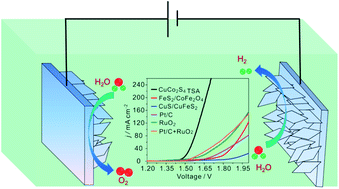Rational design of Cu–Co thiospinel ternary sheet arrays for highly efficient electrocatalytic water splitting†
Abstract
The exploration of highly efficient and scalable potential electrocatalysts for the oxygen evolution reaction (OER) and hydrogen evolution reaction (HER) is essential in the field of sustainable energy systems. In this paper, we report the successful synthesis of CuCo2S4 ternary sheet arrays (CuCo2S4 TSAs) via a simple rational one-pot solvothermal procedure. The CuCo2S4 TSA was transformed from CuCo-dihydroxide and uniformly distributed on the microfibre of carbon felt, which effectively enhanced the charge transfer rate. Benefiting from the uniform freestanding sheet structure, the coordination effect of the metal species and the high-conductive carbon skeleton, the ternary composite exhibits excellent OER and HER activity, with the lowest overpotentials of 210 and 69 mV and Tafel slopes of 43.8 and 55.4 mV dec−1, respectively, outperforming the other ternary composites of FeS2/CoFe2O4 and CuS/CuFeS2, mono-metal sulfides and commercial RuO2 and Pt/C. Besides, the CuCo2S4 TSAs exhibit superior long-term stability relative to noble metal catalysts. Moreover, the excellent overall water-splitting performance was obtained by using CuCo2S4 TSA as a catalyst, providing an effective low-cost and large-scale synthetic strategy for high-efficiency binder-free catalysts in renewable energy conversion.



 Please wait while we load your content...
Please wait while we load your content...